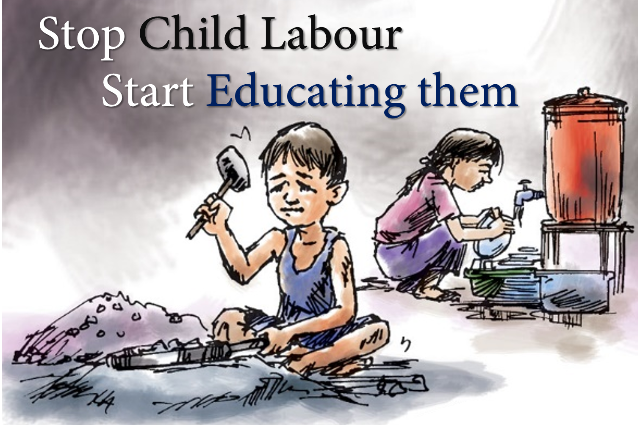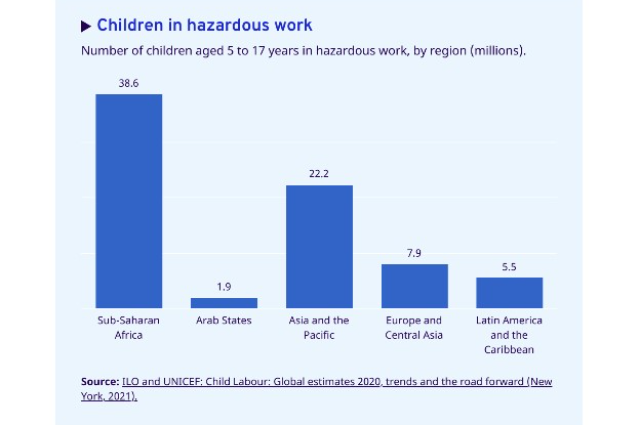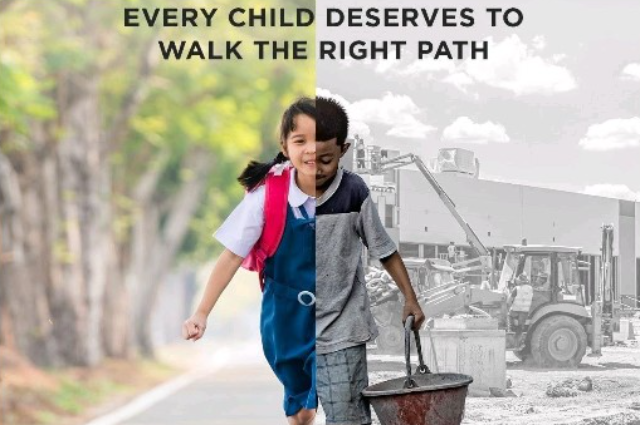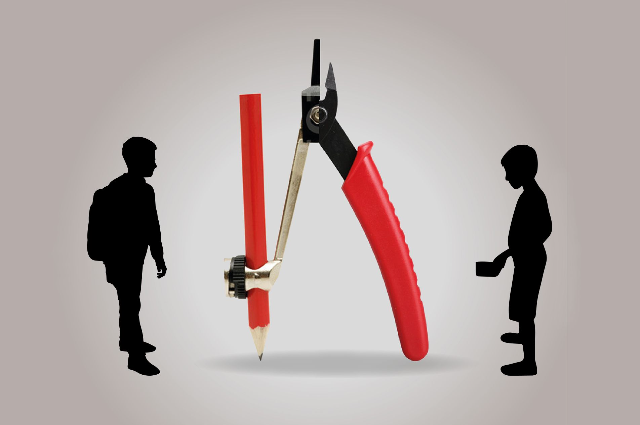Introduction
At a tender age, kids are expected to learn, play, study, and dream about what they want to be in the future but child labour snatches their dreams and makes them work hard physically and mentally to earn a little amount of money. In this article let’s see the significance of education in eradicating child labour.
Effects of the COVID-19 pandemic:
Nine million more children are at risk of being pushed into child labour by the end of 2022 as a result of the pandemic, according to the report. This number could rise to 46 million if immediate action isn’t taken. Report says there is evidence that job losses due to the COVID-19 pandemic are pushing families to turn to child labour for income. School closures also mean that children may be working longer hours or in worse conditions.
Facts on Child Labour:
- Child labour is more common in boys than in girls at every age.
- Child labour is much more common in rural areas.
- Over 70% of child labour is in agriculture.
- More than 70% of all child labour happens within families.
What is Child Labour?
Child labour refers to the exploitation of children through any form of work that deprives children of their childhood, interferes with their ability to attend regular school, and is mentally, physically, socially, and morally harmful.
“Every time child labour is practiced, an innocent childhood has vanished.”
What is not Child Labour?
Not all work done by children should be classified as child labor that is to be targeted for elimination. The participation of children or adolescents above the minimum age for admission to employment in work that does not affect their health and personal development or interfere with their schooling is generally regarded as being something positive. This includes activities such as assisting in a family business or earning pocket money outside school hours and during school holidays. These kinds of activities contribute to children’s development and to the welfare of their families; they provide them with skills and experience and help to prepare them to be productive members of society during their adult life.
Reasons for Child Labour:
- Poverty
- Overpopulation
- Debt Trap
- Unprincipled labour
- Bonded child labour
- Lack of access to quality education
- Limited understanding of child labour
The worst forms of Child Labour:
The worst forms of child labour involve children being enslaved, separated from their families, exposed to serious hazards and illnesses, and/or left to fend for themselves on the streets of large cities often at a very early age.
“A child’s childhood is for learning, don’t use their childhood for earning”
Hazardous Child Labour:
Hazardous child labour is defined by Article 3 (d) of ILO Convention No. 182 concerning the Prohibition and Immediate Action for the Elimination of the Worst Forms of Child Labour, 1999, as work which, by its nature or the circumstances in which it is carried out, is likely to harm the health, safety or morals of children.
“Children are supposed to be going to school; they don’t look good with a hand full of tools”
Position in World:
- Africa has the largest number of child labor with almost 72 million children, followed by Asia with approx. 62 million children are involved in some sort of labour work.
- The number of children stuck in child labour has risen to 160 million worldwide. 8.5 million children are dragged into child labour during the last four years. And there is an additional risk of 9 million children getting involved as an impact of Covid 19.
- Every step to prevent child labour has stalled for the very first time in the past 20 years which will reverse the earlier downward trend that saw child labor fall by 94 million between 2000 and 2016.
Position in India:
- Earlier Child labour was very common in rural India where 80% of the children are trapped in child labour, but slowly with time, this graph shifted from rural to urban India. Because of the presence of big cities with more number of the job opportunity.
- According to a report by UNICEF, there is a 54% increase in child labour for children aged between 5 to14. As per a campaign against child labour India has approx 12666377 child labourers. Uttar Pradesh has 1927997 child labourers. Delhi has over 1 million child labourers. Other leading states are Bihar, Rajasthan, Maharashtra, and Madhya Pradesh.
Consequences of Child Labour:
The consequences are staggering. Child labour can result in extreme bodily and mental harm, and even death. It can lead to slavery and sexual or economic exploitation. And in nearly every case, it cuts children off from schooling and health care, restricting their fundamental rights and threatening their futures.
Laws against Child Labour:
- Factories Act, 1948
- Mines Act, 1952
- The Child Labour (Prohibition and Regulation) Act, 1986
- Juvenile Justice (Care and Protection) of Children Act, 2015
- Right of Children to Free and Compulsory Education Act, 2009
Importance of Education against Child Labour
- Education plays a very significant role in eliminating child labor. Every year world day against child labor is celebrated on 12th June by Education International. According to Education International, early education is very important to get children out of the labor market.
- It doesn’t only help children to learn necessary skills, but also allows them to lead a decent life forward.
- Education and training are mandatory drivers of social and economic growth and democracy.
- The removal of all costs linked with education will result in a large section of society being educated.
- An approach with the mindset to educate children and drag them out of poverty will reduce the number of child labor cases we face now.
- Education is a fundamental right, over which no one has the authority to deny.
- It helps in changing people’s opinions towards life and makes them better human beings.
The connection between Child Labour and education:
Children that work cannot go to school. When they do attend, they struggle to balance the demands of school and child labour, which compromises both their education and their right to leisure. According to the latest Global Estimates, more than one-third of children in child labour are excluded from school. This severely constrains their overall life potential.
“A child’s hand is too precious to be doing work; they look good holding a mighty pencil”
The role of universities and academia:
- Universities and other academic institutions play a crucial role in the fight against child labour. They provide insights into the underlying reasons for child labour and inform policymakers and the general public on promising strategies against it. Further, these institutions have a unique knowledge base on national and regional patterns and help sensitize the population on the issue.
- It is widely accepted by many organizations, including UNICEF, the World Bank, UNESCO and the G8 Education Task Force, that education - and in particular, free and compulsory education of good quality up to the minimum age of entering into employment as defined by ILO Convention 138 - is a key element in the prevention of child labour.
- The prevention and elimination of child labour should be an integral part of education policy development and reform worldwide.
Non-formal education and training:
- Non-formal education (NFE) is crucial in smoothing the transition from work to school for child labourers who are not ready or able to make the move straight from the workplace to formal school. NFE programmes that combine basic education with practical life and work skills are responsive to the needs of former child labourers, enabling them to re-enter the labour market later and in better jobs.
- NFE is not an alternative to the state-run formal education system, but rather a stepping stone to mainstreaming children into formal schools as and when they are ready. IPEC’s non-formal or transitional education programmes have enabled former child workers to “catch up” with their peers who began their schooling at the appropriate age. In addition, IPEC reinforces the point that there should always be a strong link between such rehabilitation programmes and the formal education system since basic education is key over the long term.
- For this reason, forging close links between interventions with the aim of rehabilitating existing child labourers and interventions with the aim of preventing children from being drawn into child labour is central to IPEC’s education strategy. For former child labourers who have missed out on formal schooling, broader forms of vocational training that provide basic education, life skills (including job-seeking and work habits) and a range of transferable skills, rather than a single skill, may be the most effective.
Formal education and the prevention of Child Labour:
There is a need to develop an integrated policy and programme of action worldwide to provide quality, universal and free education that is relevant and accessible to children of poor families to which the majority of child labourers belong. Child labour concerns should be explicitly addressed and integrated into such a policy. A holistic approach to education is necessary. In addition, quality education must not stop at the primary level if young people are to be adequately prepared for the labour market and for decent work within it, rather than being confined to low-skilled, unprotected jobs in the informal economy.
Experience has shown that providing basic literacy and numeric skills through non-formal education does not guarantee that children will be permanently withdrawn from work, which is why mainstreaming these children into formal education systems is vital. Furthermore, investments in basic education normally only reach the more privileged social groups, whereas efforts should be spread more evenly, focusing more on children at risk. Social exclusion mechanisms are another strong factor that keeps children out of school and pushes them into work.
There is a need to give priority to the expansion of public educational systems to accommodate the numbers of children who still do not have access to school. This means that:
- More schools need to be built, teachers need to be recruited and trained and educational materials need to be made available.
- Alternative approaches need to be developed to provide for the education of children when geographical conditions pose obstacles or the community’s lifestyle involves mobility.
- The formal and non-formal education systems need to be linked in a more systematic manner to allow for easier transitions from the non-formal to the formal sector, and both systems need to be improved and upgraded in many countries.
- School admission and retention policies should facilitate the entry or re-entry of children into schools by providing alternative placement options and independent learning approaches with adequate guidance and support for over-aged children or children who re-enter school.
- A substantial increase in the availability of public education in rural areas at the pre-primary, primary and secondary levels will diminish the pressure and existing congestion in schools in the urban centres where poor families migrate in search of both jobs and educational opportunities for their children.
- In many cases, children in the worst forms of child labour belong to the lowest strata of society in terms of ethnicity and culture. In this regard, IPEC is working in collaboration with the ILO's INDISCO programme and ILO PRO 169 in order to understand better how these exclusion mechanisms affect the education of indigenous and tribal peoples and to develop models to counteract them. These models can then be adapted and replicated in various countries. ILO PRO 169 is the Project to Promote ILO Policy on Indigenous and Tribal Peoples which operates at the policy level. It aims to promote the rights of indigenous and tribal peoples, encourage dialogue on the issues affecting them and build the capacity of these peoples to promote and protect their own rights. IPEC is working with PRO 169 to establish the close links between indigenous children, child labour and education.
Teachers, Educators and their Organizations:
- Teachers are a key determining factor in the quality of any education system. Some teachers work under appropriate and effective conditions. However, the conditions under which many teachers have to work, particularly in developing countries where the situation of child labour is critical, are often appalling. For decades, teachers have been teaching children despite the lack of physical infrastructure, learning materials and other essential support services.
- While education systems in most countries are usually among the largest administrative sectors of government, the ultimate success or failure of the system to deliver services to millions of children depends upon the abilities and attitudes of teachers. Teachers have been expected to fulfil national educational goals and objectives despite inadequate or even inappropriate conditions for learning and teaching. In many countries, teachers are often forced to take on additional jobs in order to supplement their income out of economic necessity. These situations stretch the limits of teachers’ capacities and require a deep sense of commitment, resourcefulness and tremendous amounts of energy from them to meet expectations.
- In terms of the crucial role of education in the elimination of child labour, it therefore is vitally important to ensure that teachers are given the opportunity to provide quality education to their students. This depends upon the quality of teacher education and preparation in a country, on the policies, procedures, infrastructure and material resources that define the teachers’ working and employment conditions. In this respect, IPEC fully supports the action programme of ILO's SECTOR-Education which focuses global attention on the critical issue of the worldwide shortage of teachers.
- Providing a quality education for all requires that teachers must be supported to do their job better, through good training and improvements in their status, pay and working conditions; respect for their rights to freedom of association and collective bargaining is critical in this respect.
Conclusion
Eradicating child labour is still a distant dream for India. But education can be proved as a weapon to deal with it. Our lawmakers are trying to tackle the problem but it’s high time that we as a citizen of India help the government to solve the problem. Problems like poverty, Illiteracy leads to child labour, with a collective effort by all of us, will for sure help children to drag them out of the labour world and lead a better life ahead.
“The roadway to a healthy nation is to stop child exploitation through child labour”





